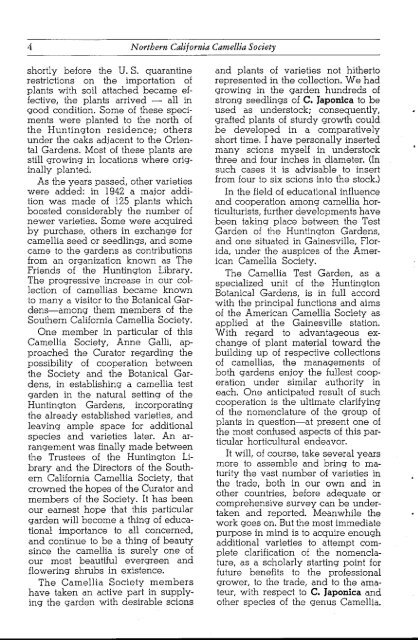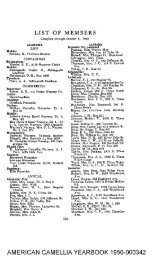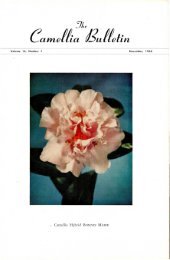CAMELLIA JAPONICA - GOVERNOR EARL WARREN - Immense ...
CAMELLIA JAPONICA - GOVERNOR EARL WARREN - Immense ...
CAMELLIA JAPONICA - GOVERNOR EARL WARREN - Immense ...
Create successful ePaper yourself
Turn your PDF publications into a flip-book with our unique Google optimized e-Paper software.
4 Northern California Camellia Society<br />
shortly before the U. S. quarantine<br />
restrictions on the importation of<br />
plants with soil attached became effective,<br />
the plants arrived - all in<br />
good condition. Some of these speciments<br />
were planted to the north of<br />
the Huntington residence; others<br />
under the oaks adjacent to the Oriental<br />
Gardens. Most of these plants are<br />
still growing in locations where originally<br />
planted.<br />
As the years passed, other varieties<br />
were added: in 1942 a major addition<br />
was made of 125 plants which<br />
boosted considerably the number of<br />
newer varieties. Some were acquired<br />
by purchase, others in exchange for<br />
camellia seed or seedlings, and some<br />
came to the gardens as contributions<br />
from an organization known as The<br />
Friends of the Huntington Library.<br />
The progressive increase in our collection<br />
of camellias became known<br />
to many a visitor to the Botanical Gardens-among<br />
them members of the<br />
Southern California Camellia Society.<br />
One member in particular of this<br />
Camellia Society, Anne Galli, approached<br />
the Curator regarding the<br />
possibility of cooperation between<br />
the Society and the Botanical Gardens,<br />
in establishing a camellia test<br />
garden in the natural setting of the<br />
Huntington Gardens, incorporating<br />
the already established varieties, and<br />
leaving ample space for additional<br />
species and varieties later. An arrangement<br />
was finally made between<br />
the Trustees of the Huntington Library<br />
and the Directors of the Southern<br />
California Camellia Society, that<br />
crowned the hopes of the Curator and<br />
members of the Society. It has been<br />
our earnest hope that this particular<br />
garden will become a thing of educational<br />
importance to all concerned,<br />
and continue to be a thing of beauty<br />
since the camellia is surely one of<br />
our most beautiful evergreen and<br />
flowering shrubs in existence.<br />
The Camellia Society members<br />
have taken an active part in supplying<br />
the garden with desirable scions<br />
and plants of varieties not hitherto<br />
represented in the collection. We had<br />
growing in the garden hundreds of<br />
strong seedlings of C. Japonica to be<br />
used as understock; consequently,<br />
grafted plants of sturdy growth could<br />
be developed in a comparatively<br />
short time. I have personally inserted<br />
many scions myself in understock<br />
three and four inches in diameter. (In<br />
such cases it is advisable to insert<br />
from four to six scions into the stock.)<br />
In the field of educational influence<br />
and cooperation among camellia horticulturists,<br />
further developments have<br />
been taking place between the Test<br />
Garden of the Huntington Gardens,<br />
and one situated in Gainesville, Florida,<br />
under the auspices of the American<br />
Camellia Society.<br />
The Camellia Test Garden, as a<br />
specialized unit of the Huntington<br />
Botanical Gardens, is in full accord<br />
with the principal functions and aims<br />
of the American Camellia Society as<br />
applied at the Gainesville station.<br />
With regard to advantageous exchange<br />
of plant material toward the<br />
building up of respective collections<br />
of camellias, the managements of<br />
both gardens enjoy the fullest cooperation<br />
under similar authority in<br />
each. One anticipated result of such<br />
cooperation is the ultimate clarifying<br />
of the nomenclature of the group of<br />
plants in question-at present one of<br />
the most confused aspects of this particular<br />
horticultural endeavor.<br />
It will, of course, take several years<br />
more to assemble and bring to maturity<br />
the vast number of varieties in<br />
the trade, both in our own and in<br />
other countries, before adequate or<br />
comprehensive survey can be undertaken<br />
and reported. Meanwhile the<br />
work goes on. But the most immediate<br />
purpose in mind is to acquire enough<br />
additional varieties to attempt complete<br />
clarification of the nomenclature,<br />
as a scholarly starting point for<br />
future benefits to the professional<br />
grower, to the trade, and to the amateur,<br />
with respect to C. Japonica and<br />
other species of the genus Camellia.




